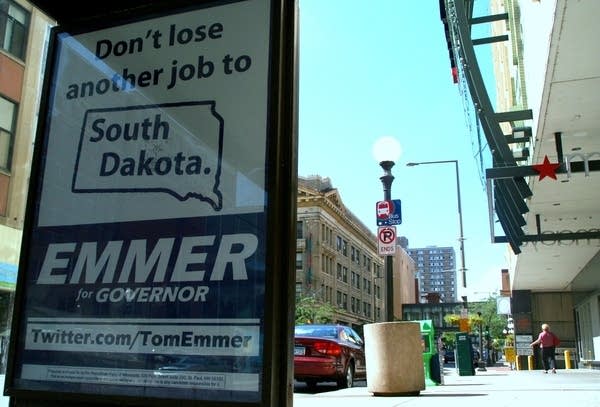Rolnick: No numbers to support claim of jobs leaving Minn. for South Dakota

Billboards paid for by the Republican Party of Minnesota are popping up across the state to support gubernatorial candidate Tom Emmer -- and point out what the party sees as a problem: jobs leaving Minnesota for South Dakota.
The party claims the friendlier tax climate in South Dakota, where there is no corporate or regular state income tax, is and could continue driving Minnesota businesses to move there.
Republicans cite companies like TCF Bank, which moved its headquarters from Minneapolis to Sioux Falls last year because it said South Dakota had a friendlier regulatory climate. A TCF spokesman said the change will have no impact on TCF's operations or employment levels in Minnesota.
The party also points to a study conducted by the Small Business and Entrepreneurship Council, which ranks South Dakota No. 1 in terms of the costs of their tax systems on small businesses, and Minnesota ranks No. 49.
Create a More Connected Minnesota
MPR News is your trusted resource for the news you need. With your support, MPR News brings accessible, courageous journalism and authentic conversation to everyone - free of paywalls and barriers. Your gift makes a difference.
But the actual number of jobs leaving Minnesota for South Dakota is difficult to measure, said Art Rolnick, former director of research at the Minneapolis Fed and now a senior fellow at the University of Minnesota's Humphrey Institute.
"We really don't have good numbers on that," he told MPR's Morning Edition.
The Emmer billboards sponsored by the Republican Party aren't the first time the issue has come up in Minnesota. Business groups in South Dakota have advertised in Minnesota about South Dakota's friendly tax laws, and politicians have gone back and forth about it for years.
"Do taxes impact economic growth? Without question they do. I think the debate is, how much?"
In 1983, South Dakota Gov. Bill Janklow summed up the jobs feud and his opinion about how Minnesota Gov. Rudy Perpich was handling it: "[Gov. Perpich has] not yet come to realize that the more he complains and publicizes South Dakota, the more he recognizes for his people that his problems won't go away, but his businesses will."
Rolnick said there's no question that a comparison of Minnesota and South Dakota's tax laws reveals that South Dakota has virtually no taxes on business. Minnesota's tax rates are more toward the middle of the pack when compared to states across the country.
"If you just look at taxes, business taxes, South Dakota has a much different structure, a much friendlier business structure," Rolnick said.
But Rolnick said Minnesota has a bigger, stronger economy than South Dakota -- the per capita income is 10 percent higher than in South Dakota and Minnesota is one of the top states for the number of Fortune 500 companies. It also has a highly educated work force and can attract businesses looking for a place that will attract good workers.
"I'm not saying taxes don't matter, but you have to look at the full picture," Rolnick said. "Over all these years when this debate has gone on, Minnesota's economy has done quite well."
The other factor that makes it hard to measure whether businesses are leaving one state for another is that there are usually many factors that lead a business to move, said Phil Krinkie, president of the Taxpayers League of Minnesota.
Krinkie agreed with Rolnick that it's hard to measure whether Minnesota's tax rates are driving businesses away, but he said it's important for gubernatorial candidates to be debating the issue.
"Do taxes impact economic growth? Without question they do. I think the debate is, how much?" Krinkie said.
Businesses on the border that can easily move are most likely to move, along with businesses like calling centers or insurance processing offices that are portable by nature, Krinkie said.
While Krinkie said Minnesota should compare its tax rates to surrounding states and consider lowering taxes, he said the state shouldn't expect to see the results lead to economic growth right away.
"I don't think anyone should say this is the silver bullet, or this is the lone point in terms of what's going to spur and change the economic climate or job growth in Minnesota," Krinkie said.
The Minnesota Department of Employment and Economic Development (DEED) doesn't keep track of how many jobs are created as a result of businesses moving into Minnesota -- or lost, as businesses leave the state to set up shop elsewhere. In South Dakota, the state's Department of Labor says it doesn't follow those types of statistics, either.
Even if DEED did keep track, studies on U.S. companies that outsource jobs to other countries have proven it's a tricky issue to analyze, said Steve Hine, state labor analyst with DEED.
"They're all fraught with what boils down to wild guesses," Hine said of the studies. "It's really difficult to pinpoint a particular job as moving from one location to another."
Even if companies are leaving Minnesota for other states, "those kinds of movements are probably a pretty small share of the total job mobility that we have ongoing," he said.
And when Hine talks to his counterparts in the Dakotas, there's an additional phenomenon at play having to do with the states' work forces.
"They're always complaining to me that all their young workers are leaving to get jobs in the Twin Cities," Hine said.
Rolnick said Minnesota's ability to keep a strong work force and grow its economy has depended on factors other than taxes. And Rolnick said Minnesota also has to remember the other factors that attract business and have led to the state's economic success.
"I would argue it has a lot to do with the quality of life and the kind of public goods we have provided over the years," he said.
(MPR's Cathy Wurzer and Curtis Gilbert contributed to this report.)
